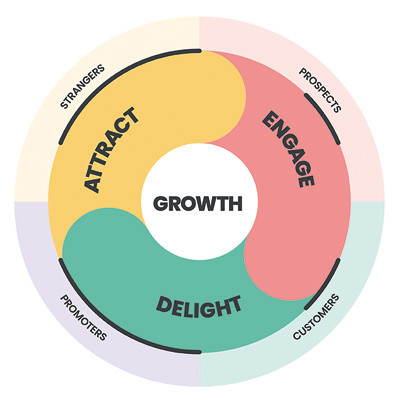JoomConnect Blog
Flywheel or Funnel: Which Lead Conversion Method is Best?
When it comes to your marketing, we’ve long been proponents of a concept known as the marketing funnel. However, we’ve recently been made aware of another marketing approach—the marketing flywheel—and thought it may be interesting to compare the two to see if, as reports say, this latter option is the more effective one for modern businesses to use.
Comparing the Funnel to the Flywheel
Let’s review how each approach works to really get an appreciation for how they divert from one another.
How a Marketing Funnel Works
We’ve talked about the marketing funnel before, but since it’s been a while, let’s break it down again.
The marketing funnel is a construct meant to assist you in optimizing your marketing processes, from acquisition to contract. Beginning at the collection phase, the start of the funnel is where you’re trying to pull in as many potential business contacts as possible, and then your continued marketing efforts make up the rest of the funnel, drawing only those who are your most qualified and promising leads through the process until you’re left with the someone ready to sign up for your services. From that point, you have the option of putting them through abbreviated funnels to upsell additional services to your new client, but otherwise, your efforts can largely focus on cultivating and maintaining a relationship between your company and theirs.
How a Marketing Flywheel Works
Alternatively, the marketing flywheel model works a bit differently. While the funnel has a distinct beginning and end, instead of a linear path, the flywheel—fitting to the name—follows a more circuitous one.
The idea is that, in addition to converting new prospects into paying customers, your marketing also focuses on continuing to cultivate interest in your existing clients. The funnel model has an entrance and an exit, whereas the wheel has no exit point and can therefore be used to continuously nurture one of your contacts at any point in the buyer’s journey. As a result, you can continue to sell your products and services to your contacts, without resetting each time a new product or service is involved. The entire thing rotates around the idea of delighting your clientele so they stick around and share their experiences with others by serving their needs.
How to Build a Marketing Flywheel
There are a few steps that go into the construction of a flywheel, starting with…
Identifying What You Can Repurpose from Your Existing Funnels
In many ways, you can take your existing sales funnels and twist them into the beginnings of a flywheel—the key performance indicators you track, the content you share, and the campaigns you run—so you can incorporate them into your new efforts. Why start from scratch if you have things that work, after all?
Identifying the Parts of the Flywheel and the Content Each Should Feature
Generally speaking, the flywheel is segmented into three sections, each with its own purpose—quite similarly to the funnel. Different pieces of content, shared with different intent, help to keep your clients and prospects along for the ride.
- In the awareness section, you’re trying to draw in your audience, which means freely available and educational content is best to share at this point. This is where a targeted and focused campaign comes in handy, as it helps them answer questions they’re seeking out the answers for and establishes you as a trustworthy source of reliable information.
- In the consideration section, your potential clients are evaluating you (and your competitors) and how well you (and they) could benefit them with your services. This is where you want to give them as much information as possible that establishes your capabilities—things like blog posts, service pages, testimonials, ebooks and whitepapers, and other such pieces of collateral.
- In the delight section, your goal is twofold: get your prospects over the last hurdle and converted into clients, and get your existing clients to start sharing how good your services have worked for them as you ready them for another lap around the wheel. Case studies and simple guides can help you accomplish this.
Identifying Which Touchpoints are Most Effective and Optimizing Them
As you do so, consider the elements of your funnels that proved most successful…what can you do to make them even more effective, or better focus on your clients and their needs? How can you help make your clients more successful in what they want to do? Giving them more options makes it more likely that they will stay involved with you.
Identifying Friction Points and Smoothing Them Out
Once your flywheel is constructed, you should confirm that there’s no sticking points that could trip up your prospects and clients as they circle around your flywheel. Do these prospects and clients have a set person that they’ll always speak to? Do they have various routes to take on the flywheel to make it to a sale? Helping your clients and prospects move through your flywheel in any way you can makes it more likely that they’ll stick with you through your next sale and beyond.
Whether you follow the funnel or the flywheel model, we can help you manage your marketing needs. Give us a call at 888-546-4384 to learn more today.



